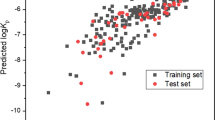Abstract
Penetration of various compounds through shed snake skin was measured in vitro to examine the effect of lipophilicity and molecular size of a compound on permeability through this model membrane. The permeabilities were found to be controlled by the lipophilicity and the molecular size of the permeant. The smaller and the more lipophilic the compound, the greater the permeability. Equations have been developed to predict the permeability from the molecular weight and the distribution coefficient of a compound. Further, the lipophilicity of shed snake skin is similar to that of human skin and the response of shed snake skin to the molecular size of a permeant is more similar to human skin than to hairless mouse skin. Considering the similarities between shed snake skin and human stratum coraeum in terms of structure, composition, and permeability characteristics, the same considerations may apply to permeability through human stratum corneum.
Similar content being viewed by others
REFERENCES
M. J. Bartek, J. A. LaBudde, and H. I. Maibach. J. Invest. Dermatol. 58(3):114–123 (1972).
P. Campbell, T. Watanabe, and S. K. Chandrasekaran. Fed. Proc. 35:639 (1976).
M. Walker, P. H. Dugard, and R. C. Scott. Hum. Toxicol. 2:561–562 (1983).
R. C. Wester and P. K. Noonan. Int. J. Pharm. 7:99–110 (1980).
T. Itoh, J. Xia, R. Magavi, T. Nishihata, and J. H. Rytting. Pharm. Res. 7:1042–1047 (1990).
M. Akazawa, T. Itoh, K. Masaki, B. T. Nghiem, N. Tsuzuki, R. Konishi, and T. Higuchi. Int. J. Pharm. 50:53–60 (1989).
G. B. Kasting, R. L. Smith, and E. R. Cooper. In B. Shroot and H. Schaefer (eds.), Skin Pharmacokinetics, Karger, Basel, 1987, pp. 138–153.
E. R. Cooper and G. Kasting. J. Control. Rel. 6:23–35 (1987).
R. H. Guy and J. Hadgraft. Pharm. Res. 5:753–758 (1988).
M. S. Roberts, R. A. Anderson, and J. Swarbrick. J. Pharm. Pharmacol. 29:677–683 (1977).
S. C. Valvani and S. H. Yalkowsky. In S. H. Yalkowsky, A. A. Sinkula, and S. C. Valvani (eds.), Physical Chemical Properties of Drugs, Marcel Dekker, New York, 1980, pp. 201–229.
Author information
Authors and Affiliations
Rights and permissions
About this article
Cite this article
Itoh, T., Magavi, R., Casady, R.L. et al. A Method to Predict the Percutaneous Permeability of Various Compounds: Shed Snake Skin as a Model Membrane. Pharm Res 7, 1302–1306 (1990). https://doi.org/10.1023/A:1015902308676
Issue Date:
DOI: https://doi.org/10.1023/A:1015902308676




